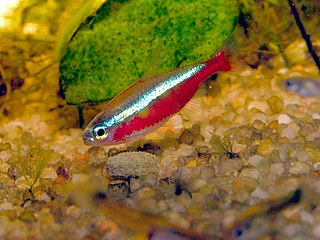 W
WThe cardinal tetra is a freshwater fish of the characin family of order Characiformes. It is native to the upper Orinoco and Negro Rivers in South America. Growing to about 3 cm (1.2 in) total length, the cardinal tetra has the striking iridescent blue line characteristic of the genus Paracheirodon laterally bisecting the fish, with the body below this line being vivid red in color, hence the name "cardinal tetra". The cardinal tetra's appearance is similar to that of the closely related neon tetra, with which it is often confused; the neon's red coloration extends only about halfway to the nose, and the neon's blue stripe is a less vibrant blue.
 W
WCyprichromis microlepidotus is an African species of fish in the family Cichlidae. It is endemic to Lake Tanganyika, where it is found in the northern part of the lake in Tanzania, Democratic Republic of the Congo, and Burundi.
 W
WThe elongate mbuna is a species of cichlid endemic to Lake Malawi where it is known from Mkata Bay and Mbamba Bay. It prefers areas with rocky substrates where it can graze on algae. It can reach a length of 9.5 centimetres (3.7 in) SL. It can also be found in the aquarium trade.
 W
WGarra barreimiae, the Oman garra, is a species of ray-finned fish in the family Cyprinidae. It is found in the mountains of northern Oman and in the United Arab Emirates. Most populations inhabit wadis, streams, pools and springs, but one population which lives in a cave system, is known as Omani blind cave fish, and has lost its sight and pigmentation. The only other cave fish in the Arabian Peninsula is the Tawi Atair garra, but it has normal eyes.
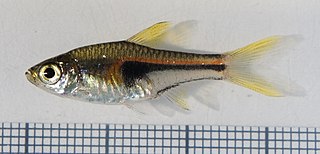 W
WThe glowlight rasbora is a species of cyprinid fish in the genus Trigonostigma.
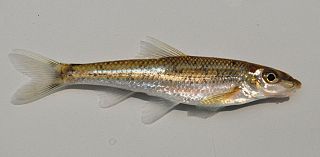 W
WThe gravel chub, also known as the spotted chub, is a freshwater minnow from the family Cyprinidae. This species of fish has a spotted distribution inhabiting various small rivers and streams in North America. The gravel chub requires a highly specific clean habitat making it vulnerable to various types of pollutants and in need of conservation efforts.
 W
WJulidochromis marlieri is a species of cichlid endemic to Lake Tanganyika where it is only known from the northwestern portion preferring rocky shorelines in deep waters. In the aquarium trade, it is commonly known as Marlier's Julie, Spotted Julie or Chequered Julie. This species reaches a length of 15 centimetres (5.9 in) TL. Adult females are larger than adult males. The specific name honours the Belgian zoologist Georges Marlier who collected the type.
 W
WLabidochromis caeruleus is a species of cichlid endemic to the central western coastal region of Lake Malawi in East Africa. It is also known as lemon yellow lab, the blue streak hap, the electric yellow or yellow prince, depending on the colour morph. A naturally occurring yellow-coloured variant from Lion's Cove is one of the most popular cichlids amongst aquarium hobbyists.
 W
WMeiacanthus kamoharai is a species of combtooth blenny found in coral reefs in the western Pacific ocean, around southern Japan. This species grows to a length of 6 centimetres (2.4 in) TL. The specific name honours the Japanese ichthyologist Toshiji Kamohara (1901-1972) of Kochi University.
 W
WMirapinna esau, the hairyfish, is a species of flabby whalefish only known from the Atlantic Ocean from near the Azores. Formerly considered a member of the no-longer-recognized family Mirapinnidae, this species is the only known member of its genus.
 W
WNannostomus espei,, commonly known as Espe's pencilfish or barred pencilfish, is a freshwater species of fish belonging to the characin family Lebiasinidae. It was first described in 1956 by Herman Meinken from the Mazaruni River system in Guyana and to date this is its only known location. It is notable amongst the genus in that the dominant body pattern consists of five broad, comma-like patches instead of the more normal horizontal stripes seen in the rest of the genus. This pattern of patches is assumed by other species at night, but only N. espei displays the pattern permanently and in daylight.
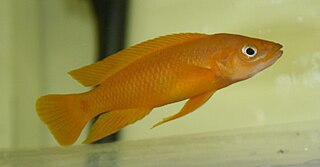 W
WNeolamprologus leleupi is a species of cichlid endemic to Lake Tanganyika where it occurs throughout the lake. It is a recess-dweller, inhabiting cracks and crevices. It feeds on invertebrates living in the rich biocover of the substrate. This species reaches a length of 10 centimetres (3.9 in) TL. The color of this fish ranges from bright yellow to deep brown depending on which area of the lake it is from. This relatively small cichlid is a substrate spawner. This fish is easily confused with the very similar N. longior a fish also endemic to Lake Tanganyika. The specific name honours the Belgian entomologist Narcisse Leleup (1912-2001), who collected the type.
 W
WThe Okefenokee pygmy sunfish, Elassoma okefenokee, is a species of pygmy sunfish found in southeastern United States, where it prefers waters with dense vegetation growth in the Altamaha drainage in southern Georgia south to Lake Okeechobee, Florida, interior lake basins in north-central Florida, and upper Suwannee, Withlacoochee, and Hillsborough river drainages on the Gulf Coast of Florida. This species can reach 3.4 cm (1.3 in) in total length.
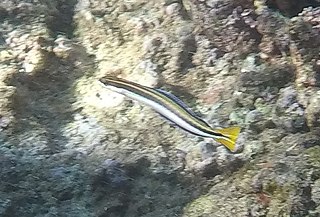 W
WPlagiotremus goslinei, the biting blenny, Gosline's fangblenny, scale-eating blenny or the scale-eating fang blenny, is a species of combtooth blenny found in coral reefs in the eastern central Pacific Ocean. This species reaches a length of 6.3 centimetres (2.5 in) SL. The specific name honours the American ichthyologist William A. Gosline (1915-2002) of the University of Hawai‘i.
 W
WThe scrapermouth mbuna is a species of cichlid endemic to Lake Malawi where it prefers areas with rocky substrates. This species can reach a length of 11.7 centimetres (4.6 in) TL. This species can also be found in the aquarium trade. Its specific name honours the British ichthyologist Ethelwynn Trewavas (1900-1993) of the British Museum.
 W
WThe slender chub is a species of ray-finned fish in the family Cyprinidae. It is found only in the United States.
 W
WThe small-headed cod or long-finned cod is a deepwater fish belonging to the morid cod family (Moridae), and related to the true cods. It is found in the Tasman Sea, including Bass Strait, and is commercially harvested by both Australia and New Zealand. It has been found on the continental shelf, but typically its depth range is from 750 to 1,000 m. It grows to 48 centimetres (19 in) in total length.
 W
WValenciennea puellaris, the Orange-spotted sleeper-goby, Orange-dashed goby, or Maiden goby,Diamond Watchman goby, is a species of goby native to the Indian Ocean and the western Pacific Ocean. It inhabits lagoons and outer reefs where it occurs on sandy substrates with larger pieces of rubble to burrow under. It can reach a length of 20 centimetres (7.9 in) SL. It is a prevalent fish in the aquarium hobby. Its main diet is composed of zoo plankton and dead fish or insects.
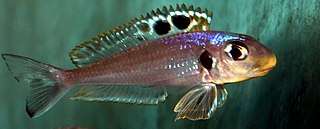 W
WXenotilapia bathyphila is a species of cichlid endemic to Lake Tanganyika where it occurs in schools in areas with sandy substrates. It feeds on small shrimps and copepods. This species can reach a length of 10.3 centimetres (4.1 in) TL. It can also be found in the aquarium trade.